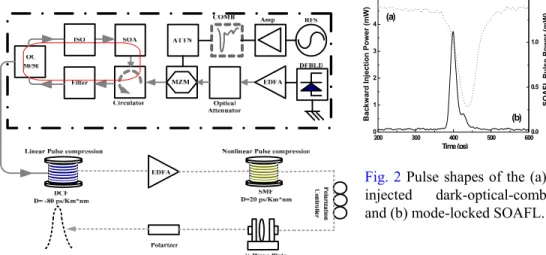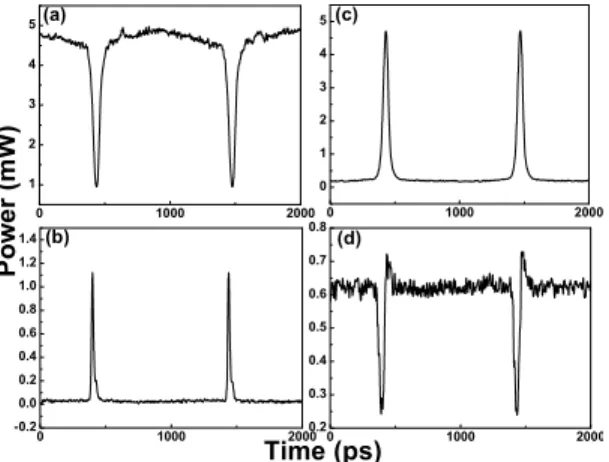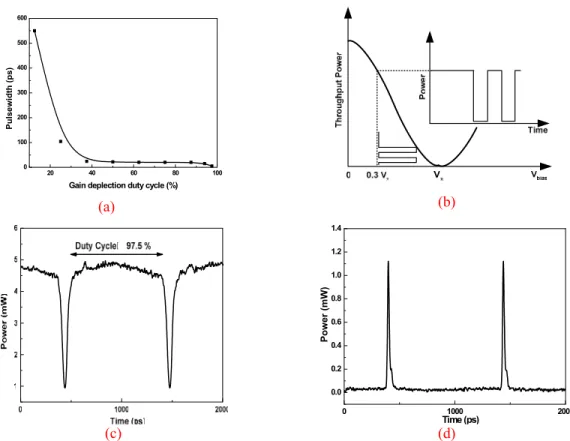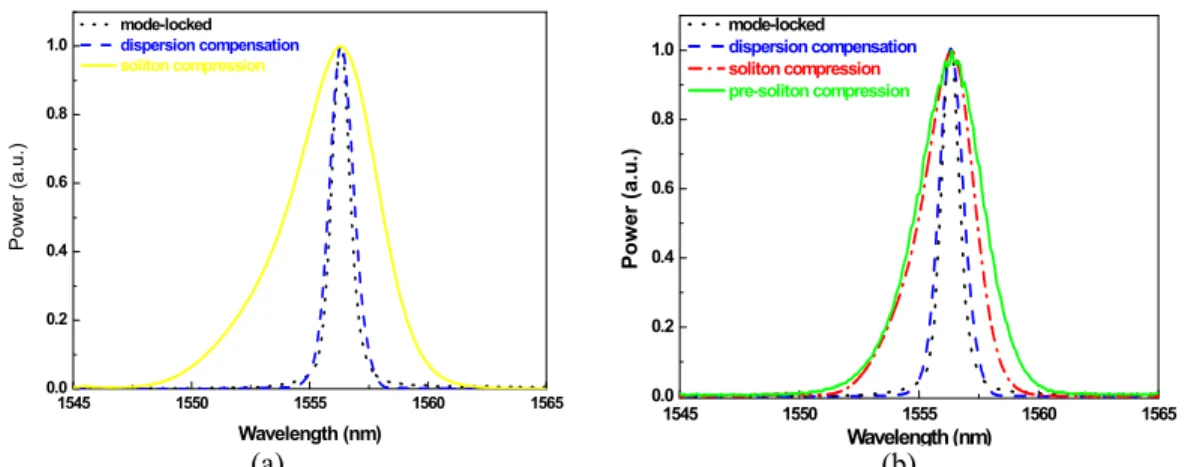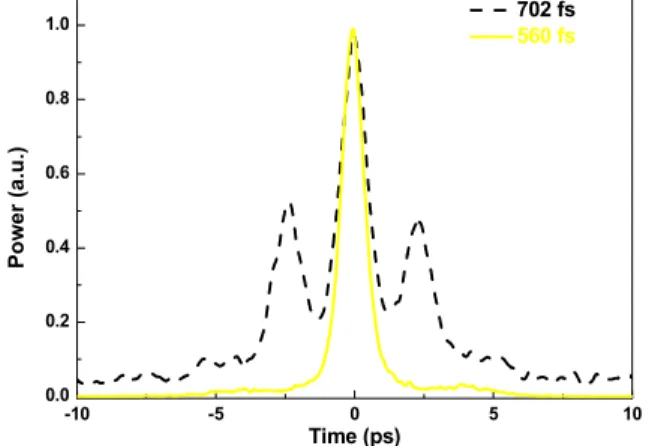Generation of 560 fs Soliton at 10 GHz from Optically
Cross-gain-modulation Mode-locked SOA Fiber Laser
I-Hsiang Chiu and Gong-Ru Lin*
1
Department of Photonics & Institute of Electro-Optical Engineering,
National Chiao Tung University,
1001, Ta Hsueh Rd., Hsinchu, Taiwan 300, R. O. C.
*
Corresponding author. Phone: 886-3-5712121 ext. 56376; Fax: 886-3-5716631; E-mail:
grlin@faculty.nctu.edu.tw
ABSTRACT
Optically harmonic mode-locking and femtosecond compression of a semiconductor optical amplifier fiber laser (SOAFL) induced by backward injecting a dark-optical-comb pulse-train at 10 GHz is demonstrated for the first time. The injected dark-optical-comb with 25-ps pulsewidth can be generated by seeding tunable laser into a Mach-Zehnder intensity modulator (MZM) at DC biased point of 0 V. The MZM is driven by a commercial electrical comb generator under an input microwave power of 28 dBm at repetition frequency of 10 GHz. Theoretical simulation indicates that the backward injection of dark-optical-comb results in a wide gain-depletion width (as well as a narrow gain window of ≤25 ps) within one modulation period, providing a cross-gain-modulation mode-locking of the SOAFL with a shortest pulsewidth of 5.4 ps at 10 GHz. The difficulty in mode-locking the SOAFL by an optical short pulse (bright-optical comb) injection is also demonstrated and elucidated by the insufficient gain-depletion time (as well as modulation depth). After propagating through a 75m-long dispersion compensating fiber (DCF), the negatively chirped SOAFL pulsewidth that is mode-locked by the backward injected dark-optical-comb can be linearly dispersion-compensated and slightly shortened to 3.9 ps. By increasing the peak power of the dispersion-compensated SOAFL pulse to 51 W and propagating it through a 76.7m-long single mode fiber (SMF), an eighth-order nonlinearly soliton compression is achieved with the pulsewidth, linewidth, and time-bandwidth product of 560 fs, 4.5 nm and 0.31, respectively.
Keywords: mode-locking, semiconductor optical amplifier, dark-optical-comb, Mach-Zehnder intensity modulator.
1. INTRODUCTION
Backward optical injection is a novel technology to achieve mode-locking in semiconductor optical amplifier based fiber-ring lasers (SOAFLs) [1-8]. The backward optical injection induced periodical gain-depletion as well as cross-gain modulation (XGM) in a SOAFL has been experimentally demonstrated and theoretically discussed [4-6]. Previously, a 4.3-ps pulse was obtained by gain-depleting the SOAFL with a compressed laser diode pulse-train at repetition of 20 GHz [2]. Similar experiments demonstrated at a higher repetition rate up to 40 GHz, a shorter pulsewidth of 1.9 ps and a wider wavelength tuning range of about 20 nm [3-5]. Particularly, the comparison between sinusoidal-wave and pulsed injection induced XGM and mode-locking were done to explain the effect of the injecting waveform on the gain-depletion dynamics and the mode-locking performance of SOAFL. The established theoretical model suggests an optimized mode-locking under sufficiently large-duty-cycle and high-level injection.
By using a loss-modulation technique via bulk or integrated electro-optic modulator, actively mode-locked erbium-doped fiber lasers (EDFLs) [9-11] with picosecond pulsewidth or ultra-high (10-40 GHz) repetition rate have emerged in early stage. However, the EDFL can not be gain-modulated due to its nature of extremely long carrier lifetime (up to several ms). The direct gain-modulation of SOA via the periodical control of driving current has previously employed as the main scheme for mode-locking the SOAFLs [12-14]. Backward optical injection is a novel technology to achieve mode-locking in semiconductor optical amplifier based fiber-ring lasers (SOAFLs) [15-18]. In particular, Patrick et al. have ever obtained a pulsewidth of 8.4 ps at 10 GHz from a similar system externally injected by a harmonically mode-locked external-cavity semiconductor laser at 10 GHz and 1543-nm. The injected pulse is optically amplified in a dual-stage 1480nm-pumped EDFA, which launches into the SOA at a mean optical power of 10 dBm [15]. Similar experiment has also been implemented by gain-depleting the SOA with a gain-switched and pulse-compressed distributed-feedback laser diode (DFBLD) [16], which generate a mode-locked pulsewidth of 4.3 ps under such a cross-gain-modulating configuration. It is realized that the SOA plays both the roles of gain medium and modulator in above works, while the mode-locking is initiated after fast periodical gain-depletion and relatively slow
Fiber Lasers III: Technology, Systems, and Applications, edited by Andrew J. W. Brown, Johan Nilsson, Donald J. Harter, Andreas Tünnermann, Proc. of SPIE Vol. 6102, 61021Y, (2006) · 0277-786X/06/$15 · doi: 10.1117/12.645440
Proc. of SPIE Vol. 6102 61021Y-1
FP bI
WH" bI EH gE CO\Ill EDEV Ix,1 oc IO DCLIE
D=30 b bI EDEV DERE1Jgain-recovery in the SOA under a strong pulse-injection. Mak, Tsang and Liu also reported a pulsewidth of 8 ps at 40 GHz from a cross-gain-modulated SOAFL [17]. Recently, the shortest pulsewidth ever generated from actively mode-locked SOAFLs were around 3.2 ps at repetition rates up to 50 GHz [18]. More recently, the use of photonic-crystal fiber (PCF) has greatly reduced the compressor length, shortened the pulsewidth (to 176 fs), and extended the wavelength (to 1630 nm via Soliton self-frequency shift) [19]. In this paper, we study the femtosecond soliton compression dynamics, the wavelength tuning and high-repetition frequency results of a backward dark-optical-comb injection induction XGM mode-locked SOAFL. The dark optical comb is employed as a novel modulating waveform with an adjustable duty cycle, which can be generated by seeding a DFBLD output into an electrical-comb biased Mach- Zehnder modulator (MZM). The SOA based XGM mode-locker is periodically gain-depleted by backward injecting the dark-optical-comb, such a scheme offers a much wider modulation bandwidth as compared to the directly electrical modulation approach. Picosecond dispersion compensation and femtosecond high-order soliton compression of such a novel backward dark-optical-comb injection mode-locked SOAFL pulse at repetition frequency up to 10 GHz is demonstrated for the first time. The effects of input pulse power and the fiber length on the pulsewidth and the time-bandwidth product of high-order femtosecond soliton are discussed. The wavelength tunability of such an optical-injection mode-locked SOAFL system is also characterized.
2. EXPERIMENT SETUP
Figure 1 illustrates the backward-optical-injection mode-locked SOAFL system with a ring cavity length of 14 m, which consists of one traveling-wave typed SOA at 1530 nm, an optical circulator, a faraday isolator, a polarizer, an 50% output coupler (OC), an optical tunable band-pass filter (OBPF), a 1/4 wave plate, and a polarization controller. The SOA with central wavelength and spectral linewidth of 1530 nm and 30 nm, respectively, was DC biased at 345 mA (well above threshold current of 50 mA). To backward optical-inject the SOA for harmonic mode-locking, a butterfly-packaged DFBLD operated at 70 mA, 1535 nm, and 25oC was amplified by an EDFA with 20dB gain and externally
modulated by a MZM. The electrical comb generator used to drive the MZM is triggered by an amplified microwave signal with power of 29 dBm. By operating the DC-bias level of the MZM at <0.3 Vπ, a dark optical-comb with
average power and pulsewidth of 4.46 mW and ≤60 ps, respectively, can be obtained at the MZM output, as illustrated in Fig. 2. The dark optical-comb is backward injected into the SOAFL via an optical circulator, which then induces a gain-depletion modulation depth of nearly 100% under fine adjustment of the SOA driving current. The use of the isolator and OBPF ensure unidirectional propagation of the circulated pulses and avoid the lasing of the injected dark optical-comb at another wavelength in the SOAFL. The harmonic mode-locking of SOAFL is achieved when the repetition frequency of the injected dark optical-comb coincides with one harmonics of the longitudinal mode in the SOAFL. 200 300 400 500 600 0 1 2 3 4 5 0.0 0.5 1.0 1.5 (a) (b) B ack w ar d In ject io n Po w er ( m W ) Time (ps) SOA FL Pul se P o we r (mW )
Fig. 2 Pulse shapes of the (a) injected dark-optical-comb and (b) mode-locked SOAFL.
Fig. 1 The schematic diagram of the backward-optical-injection mode-locked SOAFL based femtosecond soliton generator. ATT: attenuator; Amp: power amplifier; COMB: comb generator; DFBLD: distributed feedback laser diode. EDFA: erbium-doped fiber amplifier; ISO: optical isolator; OC: optical coupler; SOA: semiconductor optical amplifier; RFS: RF synthesizer.
Proc. of SPIE Vol. 6102 61021Y-2
In experiment, a highly dispersive DCF (D = -80 ps/km/nm) is chosen to reduce the propagation loss. For nonlinear soliton generation, the peak power (PN) of the input pulse required to obtain the Nth-order soliton was
theoretically derived as [15] 2 2 2 2 11 . 3 γτ π λ c D N PN = , (2)
where λ is the signal wavelength, c is the light velocity, and γ = 1.3 W-1 km-1 is the nonlinearity coefficient for a fiber
with a core diameter of 9.3 µm. The compression ratio increases with an increasing N [16]. The optical soliton is the result of interaction between the group velocity dispersion (GVD) and the self-phase modulation (SPM) effects in a fiber with anomalous dispersion. The frequency chirp induced by SPM (with a red-shifted leading edge and blue-shifted trailing edge) is simultaneously compensated by anomalous GVD after propagating through a certain distance. These two effects eventually balances each other to generate fundamental soliton traveling in a lossless fiber without any temporal and spectral changes, or to obtain higher order soliton with its original shape periodically recurring at multiples of the soliton period Z0 given by [14]
2 2 2 0 2 332 . 0 332 . 0 β πτ λ τπ = ⎟ ⎠ ⎞ ⎜ ⎝ ⎛ = D c Z , (3)
Subsequently, the residual chirp of SOAFL pulses were linearly compensated using a DCF (with dispersion parameter of D = -80 ps/km/nm). The average input power was remained at <45 mW to avoid the self-phase modulation at DCF stage. To perform soliton effect compression, the dispersion compensated pulse-train was amplified by a booster EDFA with output power of 440 mW, and was then coupled into the SMF spool (D = 20 ps/km/nm) with different lengths. The pulse shapes of the compressed soliton at different orders were further reshaping with a birefringent filter. A polarization controller was employed to control the input polarization state of the soliton pulse. A 1/4 wave plate was used to compensate the phase shift and to reconstruct linear and orthogonal polarization states for the principle and side-lobe of soliton pulse. Afterwards, a linear polarizer was used to filter out the side-lobe of soliton pulses with orthogonal polarization state. By fine-tuning such a birefringent filter located behind the SMF spool, the pulse shape after soliton effect compression can be completely pedestal-free.
3. RESULTS AND DISCUSSION
With the backward injection of the dark-optical comb, the central wavelength and output power of the harmonic mode-locked SOAFL are 1530.24 nm and 26.78 µW, respectively. The mode-mode-locked SOAFL pulsewidth significantly shrinks from 68 ps to 15 ps at a repetition frequency of 1 GHz (measured by an auto-correlator after de-convolution) as the average power of the dark-optical comb increases from 1.3 to 4.5 mW, which is already the shortest pulsewidth ever reported in similar systems at repetition rate of 1 GHz. The dark-optical comb injection-mode-locked SOAFL pulse shape is shown in Fig. 2(b). In principle, the mode-locking pulsewidth is directly proportional with (g0)1/4/(δ2 fm2
∆ν2)1/4, where f
mdenotes the modulation frequency, ∆ν represents gain bandwidth of SOA, g0 is single-pass integrated
gain of SOA, and denotes the modulation depth. The mode-locking pulsewidth reaches its minimum when the modulation depth is sufficiently high. However, the excess injecting power (up to 6.46 mW) oppositely leads to a pulse broadening due to the decrease in gain and modulation depth of the SOA. In contrast, the SOAFL mode-locked by backward injecting a bright-optical comb only shows a tiny pulse-train with an extremely large level of continuous-wave background. Such a worse mode-locking feature under backward injection of a bright-optical comb has previously been interpreted, as attributable to the insufficient gain-depletion of the SOA within one modulation period. When the SOA is gain-depleted by backward injection of a bright-optical comb, the gain of the SOA cannot be fully depleted and the SOA almost remains in the gain regime. This is due to the insufficient backward injected photon density by the bright-optical comb in one modulating period, which is far smaller than that by the dark-optical comb. This eventually contributes to a huge continuous-wave component in the SOAFL output. The optimized mode-locking scheme is to operate the SOA at a high-gain condition and then gain-deplete the SOA via a high-power dark-optical comb shown in Fig. 2(a). This eventually results in a perfect mode-locking pulse-train with peak power of 3.46 mW, as shown in Fig. 2 (b). In comparison, the backward injection of a low-power bright-optical comb (see Fig. 2(c)) with short pulsewidth only depletes the gain of the SOA in a relatively narrow duration, which leaves a large amount of residual gain in the SOA. Consequently, the backward bright-optical comb injection fails to induce sufficient modulation depth in the SOA for perfect mode-locking as shown in Fig. 2(d). The mode-locked pulse is generated
Proc. of SPIE Vol. 6102 61021Y-3
from the SOAFL, but associated with a long pedestal in the falling part. Such a continuous-wave pedestal behind the mode-locked pulses cannot be eliminated even by optimizing all of the other system parameters (except the decreasing in gain of SOA). The determination of the minimum gain-depletion width required for mode-locking the SOAFL was previously demonstrated, which clearly interpreted that a backward pulsed injection with duty cycle of 30 % contributes less to the initiation of harmonic mode-locking in the SOAFL [6]. Both the larger gain-depletion (modulation) depth and the narrower gain width of the SOA are mandatory to the build-up of the mode-locking in SOAFL. 0 1000 2000 1 2 3 4 5 0 1000 2000 0 1 2 3 4 5 0 1000 2000 -0.2 0.0 0.2 0.4 0.6 0.8 1.0 1.2 1.4 0 1000 2000 0.2 0.3 0.4 0.5 0.6 0.7 0.8 (b) Time (ps) Po w e r (mW ) (a) (c) (d)
Fig. 2. The backward optical injected (a) dark and (b) bright-optical combs, and their corresponding mode-locked SOAFL pulse-trains are shown in (c) and (d), respectively.
By backward bright- and dark- optical-comb injection mode-locked semiconductor optical amplifier fiber laser at repetition rates of 10 GHz. A traveling-wave typed SOA with gain peak at 1556 nm and linewidth of 35 nm was DC-biased at 345 mA (well above threshold current of 50 mA). A tunable laser at 1550 nm was externally modulated by a Mach-Zehnder intensity modulator (MZM) driven with an electrical comb generator (COMB) and amplified by a 28dB-gain erbium-doped fiber amplifier (EDFA), which is then used to backward inject and cross-28dB-gain modulate the SOA for harmonic mode-locking. By operating the DC-bias level of the MZM at 0 V, the dark optical-combs with pulsewidth of ≤ 25 ps can be obtained at the MZM output, as illustrated in Fig. 3(b). The intra-cavity isolator and optical band-pass filter (OBPF) ensure unidirectional propagation and avoid the lasing of the injected optical optical-comb in the SOAFL. The backward dark-optical-comb injected SOAFL are harmonic mode-locked at central wavelength and output power of the 1556 nm and 132.2 µW, respectively. Short mode-locking pulsewidth can be obtained as the gain depletion duty cycle of the SOA is greater than 40% within one period, as shown in Fig. 3(a). The experiments elucidate an optimized mode-locking condition for the SOAFL is to dissipate most of the gain in the SOA within one modulation period. This is implemented by backward injecting the SOA with a dark optical-comb shown in Fig. 3(c), which induces a gain depletion duty cycle of up to 97.5% and a nearly 100% gain-depletion modulation depth in the SOAFL. Such an operation results in a perfect mode-locking pulse-train with peak power of 2.45 mW and pulsewidth of 5.4 ps (de-convolution from an auto-correlator trace) under an injecting power of 0.5 mW, as shown in Fig. 3(d). In this experiment the shortest pulsewidth at repetition frequency of 10 GHz ever reported in similar systems before pulse compressing. Later on, a DCF spool is employed to compensate the negative chirp of the mode-locked SOAFL pulse. An explicit expression for the optimum compression condition under the first-order approximation is described as DDCFL = -∆t/∆λ [20] , where DDCF = -80 ps/km/nm is the dispersion parameter of DCF in ps/km/nm, L is the fiber
length, ∆t is the FWHM of the input pulse, and ∆λ is the chirped spectral width. Hence, we conclude the dispersion can be compensated using 75m-long DCF since the ∆t/∆λ of 6 ps/nm is obtained from experimental results. The linewidth and time-bandwidth product (TBP) of the original SOAFL pulse are 0.9 nm (∆ν = 112.5 GHz) and 0.61, respectively. After propagating through a 75m-long DCF, the auto-correlated mode-locked pulse shape becomes purely Gaussian and the pulsewidth is compressed from 5.4 ps to 4 ps at the linearly DCF stage, as shown in Fig. 4.
Proc. of SPIE Vol. 6102 61021Y-4
C a-C a O? A A 1!WG a.0 1000 oo( 0•0 C) E 1!W6(C)J Df' C1CI a2o\0 20 40 60 80 100 0 100 200 300 400 500 600 Pulsewidth (ps)
Gain deplection duty cycle (%)
(a) (b) (c) 0 1000 2000 0.0 0.2 0.4 0.6 0.8 1.0 1.2 1.4 Power ( m W) Time (ps) (d)
Fig. 3(a)The effect of gain-deplection duty-cycle on mode-locked SOAFL pulsewidth; (b)The optimized driving condition of Mach-Zehnder modulator for dark-optical comb generation; The pulse-trains of (c) dark-optical-comb and (d) mode-locked SOAFL.
Figure 5 reveals that the DCF compensated pulse exhibits an unchanged linewidth and a reduced TBP of 0.45. The input power should remain as below 45 mW to avoid the Self-phase modulation induced spectral broadening at the DCF stage. The dispersion compensated pulses is further amplified and the compressed via a nonlinear soliton pulse compression in a SMF spool. Under a sech2 pulse shape with appropriate peak power, the optical soliton is a balanced
result of the interaction between the group velocity dispersion (GVD) and the self-phase modulation (SPM) effects in SMF with anomalous dispersion. The finite gain-bandwidth limitation of the SOAFL pulse can thus be released by the SPM-induced linewidth broadening effect, and the SOAFL pulse is concurrently shortened by compensating the SPM induced residual frequency chirp with the anomalous GVD in SMF. In principle, the peak power of the input pulse required for obtaining the Nth-order soliton pulse was theoretically derived as P
N = 3.11 N2β2/γτ2 = 3.11
N2D
SMFλ2/2πcγτ2, where λ is the input wavelength, c is the speed of light, τ = 4 ps is the input pulsewidth, γ = 1.3 W-1
km-1 and D ≅ 20 ps/km/nm at 1550 nm denote the nonlinearity coefficient and the dispersion parameter, respectively, for
the SMF with a core diameter of 9.3 µm [21]. In Figure 4(a) and Figure 5(a) , the maximum peak power of the DCF dispersion compensated SOAFL amplified by a booster EDFA is up to 42.5 W (corresponding to an average power of 1.7 W at repetition frequency of 10 GHz), which is sufficiently to generate an third-order soliton in the SMF spool. However, it should be cautionary that the multiple-pulsing effect could manifest at extremely high pulse energies. The soliton theory indicates that the high-order soliton will follow a periodic evolution with its original pulse shape recurring at multiples of the soliton period Z0 [20], which is given by Z0 = 0.332cτ2π2/DSMFλ2. In our case, the optimized fiber
length to obtain the shortest compressed pulse for an second-order soliton is approximately equal to 0.245Z0 or 80.6 m
[22], where the estimated soliton period (Z0) is about 329 m at 1556 nm. As a result, the nonlinearly compressed
soliton pulse shape and corresponding spectrum after passing through SMF are shown in Figure 4 and Figure 5, which exhibits a Sech2-like pulsewidth and a spectral linewidth of 702 fs and 4.2 nm, respectively.
In Figure 4(b) and Figure 5(b) , the maximum peak power of the DCF dispersion compensated SOAFL amplified by a booster EDFA is up to 11 W (corresponding to an average power of 0.44 W at repetition frequency of 10 GHz), than injected into 257m-long SMF. Upon increasing the EDFA output power to 51 W (corresponding to an average power of 1.7 W at repetition frequency of 10 GHz), the pulses reached the point of second optimal narrowing to 702 fs.
Proc. of SPIE Vol. 6102 61021Y-5
Nonetheless, the soliton-effect compression is more pronounced at the central part than at the side-lobe of the linearly chirped SOAFL pulse, such an inherent drawback (requiring sufficiently high peak energy) inevitably leads to a broadened pedestal split from the compressed pulse, as seen in Fig.6.
-15 -10 -5 0 5 10 15 0.0 0.2 0.4 0.6 0.8
1.0 mode-lockeddispersion compensation
soliton compression P o w er (a .u.) Time (ps) (a) -15 -10 -5 0 5 10 15 0.0 0.2 0.4 0.6 0.8 1.0 mode-locked dispersion compensation soliton compression pre-soliton compression P o we r ( a.u.) Time (ps) (b)
Fig. 4 Comparison of SOAFL pulse shapes after mode-locking (dotted curve), linear dispersion compression (dashed curve) and (a) 80.6m-SMF1 (solid curve), (b) 257m-SMF2 (Dash-dotted curve), 17m-SMF3 (solid curve).
1545 1550 1555 1560 1565 0.0 0.2 0.4 0.6 0.8 1.0 mode-locked dispersion compensation soliton compression Powe r (a.u. ) Wavelength (nm) (a) 1545 1550 1555 1560 1565 0.0 0.2 0.4 0.6 0.8 1.0 mode-locked dispersion compensation soliton compression pre-soliton compression Po w er ( a. u .) Wavelength (nm) (b)
Figure 5 Lasing spectra of dark-optical comb mode-locked SOAFL pulse before (dotted curve) and after propagating through a 75-m DCF (dashed curve) and (a) 80.6m-SMF1 (solid curve), (b) 257m-SMF2 (Dash-dotted curve), 17m-SMF3 (solid curve)
In most cases, there is only 80% of the total energy confined within the central part of an third-order soliton even at an optimized propagation distance [22]. Fortunately, the intensity dependent polarization characteristic of the amplified SOAFL pulse in the SMF spool intensity-dependent nonlinear birefringence, which results in an efficient discrimination between the high intensity peak and the low intensity pedestal [21], This offers an alternative way to further suppress the unwanted pedestal of the third-order soliton pulse after passing through the SMF spool of optimized length. Consequently, the high intensity peak and the low intensity pedestal with different polarization states at the fiber output can be orthogonally separated each other by passing through a λ/4-wave plate and a linear polarizer. The polarization-mode dispersion induced side-lobe in the auto-correlated trace of the backward optical-comb injection-polarization-mode-locked SOAFL pulse shape can be gradually suppressed via the fine tune of the linear polarizer, as shown in Fig. 6. The pedestal-free pulse is eventually narrowing to 560 fs, which becomes comparable with those ever reported for a gain-switch laser diode system (with compressed pulsewidth of 185 fs) [21]. The compressed pulsewidth and linewidth curves indicates a two-stage soliton pulse compressing phenomenon. The SPM and GVD is completely balanced when the input peak power increases to 400 mW or larger, wherein the pulsewidth and linewidth of the compressed SOAFL pulse abruptly shortens to 560 fs and broadens 4.5 nm, providing a nearly transform-limit TBP of 0.31. To date, this is
Proc. of SPIE Vol. 6102 61021Y-6
already the shortest pulse ever reported for the actively harmonic mode-locked EDFLs or SOAFLs using either loss or gain modulation schemes
-10 -5 0 5 10 0.0 0.2 0.4 0.6 0.8 1.0 702 fs 560 fs Po w er (a.u .) Time (ps)
Fig. 6 The suppression of polarization-mode dispersion induced side-lobe in the auto-correlated trace of the backward optical-comb injection-mode-locked SOAFL pulse shapes. Dashed curve: partially controlled polarization mode by adjusting the polarization controller. Solid curve: pedestal-free pulse shape via the fine adjustment of input power at DCF stage.
4. CONCLUSION
We have primarily investigated the femtosecond soliton compression and wavelength tuning of a backward dark-optical-comb injection mode-locked SOAFL at repetition frequency of 10 GHz. The shortest pulsewidth of 560 fs at repetition frequency of 10 GHz after linear dispersion compensation, nonlinear soliton compression and birefringent filtering is demonstrated. After propagating through a 75 m-long DCF for dispersion compensation, the mode-locked SOAFL shrinks its pulsewidth 3.9 ps, without changing its spectral linewidth. The DCF compensated SOAFL pulse is further amplified to a peak power of 51 W for eighth-order femtosecond soliton generation. Theoretical calculation on the optimized SMF length of 76.7 m for nonlinear soliton compression is provided. The nonlinear soliton compression further increases the linewidth of the SOAFL pulse to 4.5nm, while the TBP is reduced to a transform-limit of 0.31. By extending the repetition frequency of dark-optical-comb up to 10 GHz, the mode-locked SOAFL pulsewidth can be slightly shortened from 5.4 ps to 3.9 ps after dispersion compensating, and further to 560 fs after second-order soliton compression. The lasing linewidth, the time-bandwidth product and the pulsewidth suppression ratio of the SOAFL soliton become 4.5 nm, 0.33, and 10, respectively.
ACKNOWLEDGEMENT
This work was supported in part by the National Science Council (NSC) of the Republic of China under grant NSC 93-2215-E-009-007 and NSC 94-2215-E-009-040.
REFERENCES
1. D. M. Patrick, “Modelocked ring laser using nonlinearity in a semiconductor laser amplifier,” Electron. Lett. 30, 43-44 (1994).
2. T. Papakyriakopoulos, K. Vlachos, A. Hatziefremidis, and H. Avramopoulos, “20-GHz broadly tunable and stable mode-locked semiconductor amplifier fiber ring laser,” Opt. Lett. 24, 1209-1211 (1999).
3. M. J. Guy, J. R. Taylor and K. Wakita, “10 GHz 1.9 ps actively modelocked fibre integrated laser at 1.3 m,” Electron. Lett. 33, 1630-1632 (1997).
4. M. W. K. Mak, H. K. Tsang, and H. F. Liu, “Wavelength-tunable 40 GHz pulse-train generation using 10 GHz gain-switched Fabry-Perot laser and semiconductor optical amplifier,” Electron. Lett. 36, 1580-1581 (2000).
5. L. Schares, L. Occhi, and G. Guekos, “Picosecond wavelength tunable SOA-based laser sources at 10-40 GHz repetition rates,” Conference on Lasers and Electro-Optics, Technical Digest, (Optical Society of America, Long Beach MD, 2002), CML3., 56-57.
6. G.-R. Lin, Y.-S. Liao, and G.-Q. Xia, “Dynamics of Optical Backward Injection Induced Gain-Depletion Modulation and Mode-Locking of Semiconductor Optical Amplifier Fiber Laser,” Opt. Express 12, 2017-2025
Proc. of SPIE Vol. 6102 61021Y-7
(2004).
7. D. H. Kim, S. H. Kim, Y. M. Jhon, S. Y. Ko, J. C. Jo, and S. S. Choi, “Relaxation-Free Harmonically Mode-Locked Semiconductor-Fiber Ring Laser,” IEEE Photon. Technol. Lett. 11, 521-523 (1999).
8. J. He and K. T. Chan, “All-optical actively modelocked fibre ring laser based on cross-gain modulation in SOA,” Electron. Lett. 38, 1504-1505 (2002).
9. E. Yoshida, Y. Kimura, and M. Nakawa, “20 GHz, 1.8 ps pulse generation from a regeneratively modelocked erbium-doped fibre laser and its femtosecond pulse compression,” Electron. Lett., vol. 31, pp. 377-378, 1995. 10. M. Nakazawa, and E. Yoshida, “A 40-GHz 850-fs regeneratively FM mode-locked polarization-maintaining erbium
fiber ring laser,” IEEE Photon. Technol. Lett., vol. 12, pp. 1613-1615, 2000.
11. Lingze Duan, J. K. Richardson, and Julius Goldhar, “A Stable Smoothly Wavelength-Tunable Picosecond Pulse Generator,” IEEE Photon. Technol. Lett., vol. 14, pp. 840- 842, 2002
12. M. J. Guy, J. R. Taylor and K. Wakita, “10 GHz 1.9 ps actively modelocked fibre integrated laser at 1.3 m,” Electron. Lett. vol. 33, 1630-1632, 1997.
13. D. H. Kim, S. H. Kim, Y. M. Jhon, S. Y. Ko, J. C. Jo, and S. S. Choi, “Relaxation-Free Harmonically Mode-Locked Semiconductor-Fiber Ring Laser,” IEEE Photon. Technol. Lett. vol. 11, 521-523 (1999).
14. L. Schares, R. Paschotta, L. Occhi, And Guekos, “40-GHz Mode-Locked Fiber-Ring Laser Using a Mach-Zehnder Interferometer With Integrated SOAs,” J. of Lightwave Technol. vol. 22, pp.859-873, 2004.
15. D. M. Patrick, “Modelocked ring laser using nonlinearity in a semiconductor laser amplifier,” Electron. Lett. vol. 30, 43-44 (1994).
16. T. Papakyriakopoulos, K. Vlachos, A. Hatziefremidis, and H. Avramopoulos, “20-GHz broadly tunable and stable mode-locked semiconductor amplifier fiber ring laser” Opt. Lett., vol. 24, pp. 1209-1211, 1999.
17. M. W. K. Mak, H. K. Tsang, and H. F. Liu, “Wavelength-tunable 40 GHz pulse-train generation using 10 GHz gain-switched Fabry-Perot laser and semiconductor optical amplifier,” Electron. Lett. vol. 36, pp 1580-1581, 2000. 18. Kyriakos Vlahos, Chris Bintjas, Nikos Pleros, and Hercules Avramopoulos, “Ultrafast semiconductor-based fiber
laser sources,” IEEE Journal Of Selected Topics In Quantum Electronics, vol. 10, pp. 147-153, 2004.
19. K. S. Abedin, and F. Kubota Yoshida, “Wavelength tunable high-repetition-rate picosecond and femtosecond pulse sources based on highly nonlinear photonic crystal fiber,” IEEE J. Quantum Electron., vol. 10, pp. 1203-1210, 2004. 20. H. F. Liu, Y. Ogawa, S. Oshiba, and T. Nonaka, “Relaxation-free harmonically mode-locked semiconductor-fiber
ring laser,” IEEE Journal Of Quantun Electronics.,vol. 11, pp. 1655-1660, 1991.
21. K. A. Ahmed, K. C. Chan, and H. F. Liu, “Femtosecond pulse generation from semiconductor lasers using the soliton-effect compression techique,” IEEE J. Quantum Electron., vol. 1, 592-600, 1995.
22. L. F. Mollenauer, R. H. Stolen, and J. P. Gordon, “Extreme picosecond pulse narrowing by means of soliton effect in single-mode optical fibers,” Opt. Lett., vol. 8, pp. 289-291, 1983.
Proc. of SPIE Vol. 6102 61021Y-8
